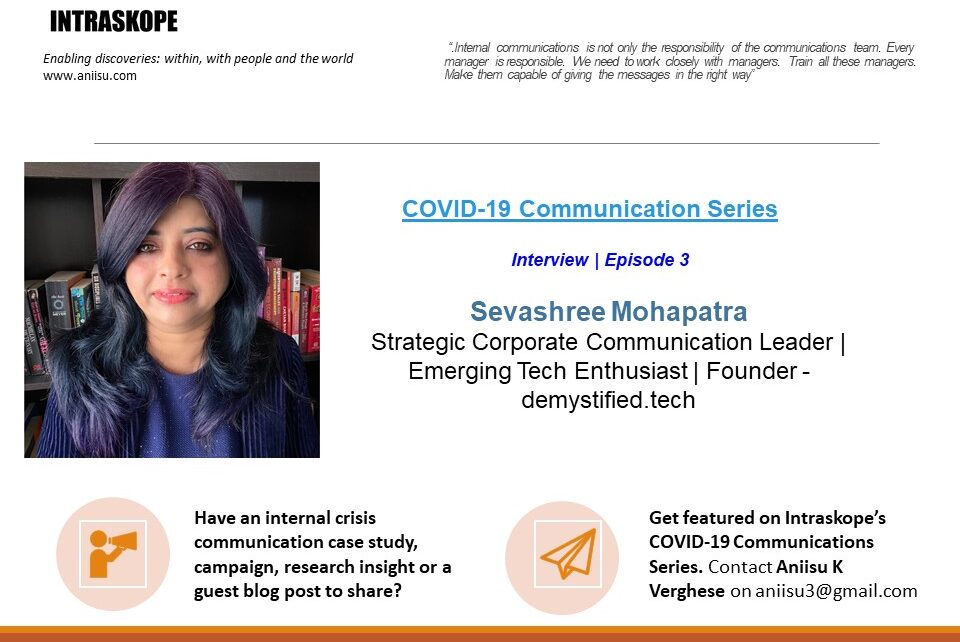How did communicators manage through the crisis? What worked and what could have been done better? what kind of approaches, content messages and channels were used? How did they measure the effectiveness of the communications? Read all this and more in this interview with Sevashree Mohapatra who headed Communications for a leading global water, sanitation, waste collection and recovery activities firm in India.
Please note that the interview was done in 2021 and some of the insights relates to specific situations at a point in time. Sevashree’s views in this interview are personal.
- How did internal communications work during COVID-19?
While as internal communicators we claim to be experts in crisis management, however, when COVID-19 hit us, it was tough to manage initially. Crisis or no crisis, internal communication is the most important aspect of managing tough situations. The focus of internal communications was to communicate with employees and stakeholders using a variety of methods. Considering the challenges of lockdown and health and safety aspects, we had to adapt to the changing situation.
2. What perceptions did you have as a practitioner on the value and impact of internal communications?
COVID-19 bought to the fore a lot of elements that were internal to us. When we talk of culture, there are a few topics and messages we generally focus on—for example, health and safety. My organization is in the domain of essential services, and our employees work across the country. Our 5000+ people in India work in plants, offices, construction, operations, and on the go. Many of them work in public spaces, especially water distribution, sewer network maintenance, and customer services projects. Unlike the IT industry, which has a homogeneous set of staff, we have a diverse workforce, and the communication also has to be in the local languages. That apart, we have experts from overseas involved. In March 2020, when we were into the pandemic, it happened too quickly. However, our work needed to continue because, like hospitals, police, and other essential services, we also must ensure the water supply and treatment weren’t impacted. We couldn’t take a break. The first step was to ensure essential services. We had to make our employees understand the scenario while keeping them safe as they continued to work. If they were impacted, we couldn’t continue. Our company has a strong SOP in crisis management, and given the situation, the health and safety team took the lead. We had to embed communication using all the tools. Clients were concerned, and they needed support. People didn’t know what a lockdown was or meant. There was chaos initially.
3. When was the communications team involved?
The communications team was involved from the very first day. We had to mobilize internally and fast. An internal group was in place, which was an extension of the Crisis Management Group. While crisis management team is usually centralized, at the HO level – we had to also decentralize to ensure the local nuances were addressed. The message was clear – We Are With You. We had the systems in place and were mindful of what can be done and go wrong. For the Waves 1 and 2, we used different messages and approaches. For Wave 1, we used By Your Side (hashtag) with videos and photos, showing how employees are fully mobilized and supplying the needs of customers. Social media was used extensively and we did campaigns city by city showing people that work continues as usual. We received a huge positive response. Our workers were shown empathy by citizens, flowers showered on workers demonstrating gratitude. They were provided water and food and our campaign captured all those imageries.
Wave 2 was brutal. Lots of employees were impacted like how the country was impacted. In this case, we had to be more sensitive to employees and highlight care and compassion. We coined the campaign – You Are Essential, where the pitch was that employees are valued and their families are important. That we matter as human beings was part of the India campaign which touched people because it was a direct message.
4. What were the key channels used?
The first communication tool we used was a preparatory note that was distributed externally and internally. This covered the preparation we are doing to keep people informed. Because of global reach of the company and the pandemic, our China and Europe locations were getting impacted initially. At the group level, we organized a working team with direct interaction with communicators. We had frequent discussions and tapped into the experience of managing the crisis in China.
5. How was communication created, reviewed and published? What employee communication actions were done – was it to search, interpret and share?
We used our internal digital magazine to communicate primarily. Other channels were e-mail and team briefings. Due to the lack of infrastructure during Wave 2 (lack of beds, oxygen cylinders etc), there was a lot of negativity. Everyone got impacted in some form – directly or indirectly. Our goal was to capture positive stories, the experiences of employees by inviting them to share with other team members.
6. What were the biggest challenges and opportunities for communicators? Why?
One of the biggest struggles was with gathering content and footage. Often, communicators are used to engaging agencies who are professionals, and they manage the shoot in the office and sites. During the peak days of the Covid crisis, the challenge was to make employees contribute and share content. They had to become the “director of their own show”. How can we put it on our social media platforms if we don’t have quality footage? It was tough at times as we would not receive the quality we expected – there was background noise, and the quality was low. We needed to have a good number of ambassadors who could be trained and send in content. But getting the right material during the lockdown and later, especially with safety measures in place, was tough.
The other challenge was that the overcommunicating of safety messages saturated staff. It became over burdening – no one wanted to read these same messages over and over. There was a limit to it. They would also dismiss it as the same content coming repeatedly. How much could they consume? People fed up with posters. We have to communicate a lot using stories. For example, with vaccinations – people were not convinced, there were issues and hesitation. The journey from “By Your Side” to “You Are Essential”, we saw a huge shift in mindset among staff.
The opportunity I saw was that internal communications role went beyond the usual remit. Internal communications was not the only responsibility of the communications team. Every manager is responsible. We needed to work closely with managers. Train all these managers. Make them capable of giving the messages in the right way. The communications team must take the lead and build capabilities of people. At all levels. Not just digital or intranet or Yammer. People are the important channel of messaging. COVID has changed the traditional ways of communicating.
7. What specific lessons did they learn from the pandemic and the communications related to it?
It is important to build a strong network of ambassadors who are trained.
8. Which skills were the most valued during this time?
It was important to have a 360-degree view of the activities that our teams were doing. The dependency on agencies can’t be there anymore. Everything was done by the teams themselves during COVID-19 including leaders who had to create messages from their homes and on their phones.
Thanks to the internal digital tools, the flow of messaging was smooth and efficient Most importantly, we need to stay grounded and keep a finger on the pulse and stay updated about business. The need to understand customers’ challenges and how we support them is crucial. We need to be seen as trusted partners.
9. What advice do communicators have for their peers?
We cannot manage without content. And content can only happen when you talk with people, in touch with everyone. In normal times it works but in such situations we need to understand every bit of business. Stay connected, talk to the teams at sites more often.
10. What measures of success were used to gauge the effectiveness?
We struggled to have concrete or substantial data to prove that it worked. We saw a significant increase in the number of employees participating on social media. It gave us a good sense of how we were doing through shares people did. We noticed a lot more engagement on the intranet. However, it was challenging to make them write feedback. People are comfortable with writing on social media. On internal channels – they are hesitant. When I speak and do calls with employees, we get to hear the comments that they loved the work done.
Missed the earlier episodes of the COVID-19 Internal Communications Interview Series? Read it here – Nazia Nasim (Royal Enfield – India) and Ruchika Sharma (Cognizant).
Have other insights to share? Join the COVID-19 Internal Communications Interview Series! Drop a mail to me at [email protected]

